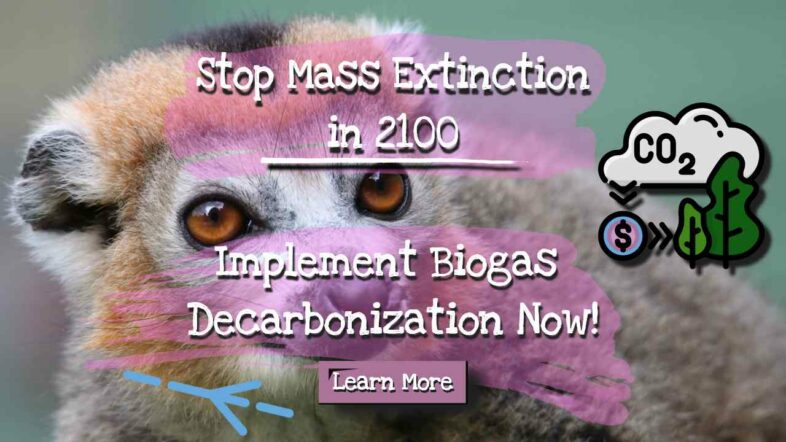Concerned about accelerating mass extinction in 2100, and subsequently? Read this to find out how maximising biogas production now is an essential tool towards the decarbonization of Europe.
By decarbonising quickly the benefits accrue over the years and provide much more benefit in reduced temperature rises, than by doing this later. Scroll down to read the Press Release by the European Biogas Association and be inspired!
Why Stop Mass Extinction in 2100. What's the Problem?
Read Our Warning Below:
“Attention all inhabitants of our planet:
The scientific community has reached a consensus that if immediate and drastic action is not taken to address climate change, the consequences will be catastrophic.
Rising temperatures and rapidly increasing sea levels are predicted to lead to widespread species extinction and irreversible damage to our ecosystems by the end of this century.
The time to act is now.
We must reduce our carbon footprint (also known as decarbonisation), transition to renewable energy sources, and protect our natural habitats before it is too late.
The future of our planet and all its inhabitants depend on it. Let us work together to secure a sustainable and habitable world for generations to come.”
10 Species at Risk of Mass Extinction in 2100: The Impacts of Climate Change and Human Activities
- Polar Bears: As sea ice continues to melt, polar bears are losing their habitat and their primary source of food, putting their survival in jeopardy.
- Coral Reefs: Rising ocean temperatures are causing coral bleaching, leading to the decline of coral reefs which serve as crucial habitats for numerous marine species.
- Sea Turtles: The increasing temperatures of the sand where sea turtles lay their eggs is causing a skewed gender ratio, putting their populations at risk.
- Orangutans: Deforestation for agriculture and palm oil production is destroying the rainforests where orangutans live, putting their populations at risk of extinction.
- African Elephants: The illegal ivory trade and habitat loss caused by human activities are threatening African elephant populations, which could see a decline of up to 50% in the next decade.
- Snow Leopards: Snow leopards are threatened by habitat loss, prey decline, and poaching due to overgrazing by livestock, as well as poaching for their fur.
- Whales: Whaling, plastic pollution, and the effects of climate change on their food sources are putting whale populations at risk of extinction.
- Penguins: Climate change is causing declines in the populations of krill and other fish, which are the primary food source for penguins, putting their survival in jeopardy.
- Rhinos: Rhino populations are threatened by poaching and habitat loss, as well as the illegal trade in rhino horns.
- Monarch Butterflies: The decline of milkweed, the primary food source for monarch butterflies, due to the use of herbicides and deforestation, is putting their populations at risk of extinction.
These are just a few examples of the many species that are in danger of extinction due to the effects of climate change and human activities.
It is important that we take immediate action to decarbonise quickly to protect these species and their habitats to ensure their survival and the health of our planet.
EC President Promises a Decarbonisation First for Europe
Ursula von der Leyen, the new President of the European Commission has committed to making Europe the “first climate-neutral continent.”
Her mandate begins with a strong political commitment to reducing carbon emissions (decarbonisation).
The next five years will be vital, these being the world’s last chance to slow down climate change and minimise the acceleration of mass extinction in 2100, as the world heads toward the end of this century.
Sympathetic Legislative Framework Needed
A legislative framework enabling the large-scale deployment of sustainable biogas and biomethane will be of critical importance to decarbonising industrial processes, and transport and help balance the grid if mass extinction by 2100 is to be avoided
Using Biogas Leads to Decarbonisation
Biogas is produced through the anaerobic digestion or gasification of agricultural wastes, energy crops, sewage sludge, biodegradable wastes or wood residues from industry, households and commercial uses.
By just simply making and using biogas we will be decarbonising!
Biogas the Flexible, Renewable, Enabler of Decarbonization Reducing Mass Extinction in 2100
Versatile Energy Borrowed from the Sun and Used for All Purposes

Its versatility allows its use for energy production, in power, heat and transport sectors, as well as in industrial processes.
Decentralized biogas production and use in rural areas offer the opportunity to green the agricultural sector, provide rural communities with a sustainable source of energy and diversify farmers’ income.
Reliable Revenue from Biogas 24/7 365 Days a Year Energy Supply
Biogas generation offers operators reliable revenue.
This is a decisive factor for the long-term prospects of most farming businesses.
Biogas is readily transportable and has proven to be highly efficient in reducing CO2 and Greenhouse Gas (GHG) emissions.
AD Already Providing Enough Energy to Save the Annual Emissions of Bulgaria
In 2017, thanks to biogas use, the EU was able to cut about 61 Mt CO²eq, of GHG emissions saving roughly the equivalent of the annual emissions of Bulgaria, representing 1.3% of the annual EU GHG emissions. The proportion will have risen since the 2017 figures and be even greater now, in 2019.
Getting the EU Significantly Closer to Decarbonising
This demonstrates how a fully developed biogas contribution can get the EU significantly closer to cutting its emissions by 40% by 2030.
The potential of biogas is confirmed by the recent rapid increase in its production.
Growth in Biogas Production
Biogas output has risen 25 times since 1990, with over 17,783 installations in Europe.
Recent years have seen real growth in biogas’s upgraded version, to practically pure methane, which is known as “biomethane”.
3 Times as Many Biomethane Upgraded AD Plants
Since 2011 the number of EU biomethane plants has tripled.
This upgraded version of biogas, containing 96% or more of methane, has the advantage of having the same characteristics as natural gas.
Biomethane can be therefore injected in the natural gas grid or used in any other sector where natural gas is used today.
France Catching Up With Germany in Numbers of Operational Biomethane Plants

While Germany historically counts the highest number of biomethane plants, France had the highest growth rate for biomethane plants in 2017 and 2018.
This was due to favourable policy conditions and aims to reach 1,000 biomethane plants injecting their gas into the national gas grid by 2020.
The French example demonstrates that by introducing favourable legislative frameworks and incentives, biomethane production can drastically increase.
Equally, to un-tap the potential of biomethane the EU should gear up for its large-scale deployment.
Fossil Fuels Subsidies Should be Phased-out
To achieve this the European Biogas Association says that fossil fuels subsidies should be phased-out, out and replaced by a credible carbon price reflecting the cost of inaction.
“If we are to achieve climate targets and we want a real transition towards a circular economy, it is crucial to unlock the full potential of all renewable energy sources. Scaling up biogas and biomethane production means promoting renewable energy and fertilisers, but also standing by local development, efficient agriculture and sustainability.”
Said Susanna Pflüger, Secretary General of the EBA.
Source: An interpretation of EBA Press Release dated 8 August 2019.
[Updated February 2023.]






Hello, I enjoy reading your article post. I am sure this has touched all readers who are concerned about biodiversity issues.
I am write a comment in support. I filled in your website box with a link to an article which I think your readers should take notice of.
One telling fact given the linked article is that “The loss of species and habitats poses as much a danger to life on Earth as climate change does…”.
So maybe campaigners for global action for sustainable living should be pushing the species extinction point.
Proving species loss could be a lot easier to prove to climate change doubters.
Busca nas ferramentas de busca por conteúdo. Search for facts and use the tool to find information and everywhere you see how serious this problem is. I am please to see someone giving the news of a solution to this.